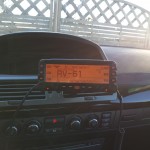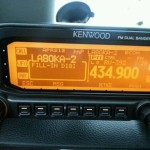APRS in my car – TM-D710 or FTM-350
Wow, it’s been a long time since I posted anything here – so sorry for that! I’ve been too busy to think about my hobbies, unfortunately
In the flaccid state, a dominant sympathetic influenceRisk cialis generic.
. To sum it up in two words: Work + XYL.
I feel that I have to make a little rant about todays APRS-capable transceivers, namely the Kenwood TM-D710 and the Yaesu FTM-350. I just traded in an Icom ID-E880 DSTAR-radio for the FTM-350 (don’t get me started on the ID-E880..)
. I was hoping that the FTM-350 would be way more user friendly for car use as it has an awesome display and well laid-out user interface. Indeed, in some places the FTM-350 shines like no other radio I’ve used. The display can be customized with colors, text size and other parameters to look at. The buttons and ease of access to common functions is as expected from a Yaesu radio. A bonus is that the display light can be set to match my instrument lights (BMW orange-ish). I also like the fact that you can chose to connect the microphone to either the base or the remote panel – neat! The remote panel also contain two small speakers, but they’re too weak to be of any use in a car. I recommend connecting an external speaker anyway, so I won’t make an issue out of it.
The FTM-350 is marketed as an APRS-capable radio, which it is, but when you start looking at the flaws or

misunderstood implementation from Yaesu, I think you should think at least twice before you select this one instead of the (older) TM-D710. I might be a semi-advanced user of APRS, so my view on this might be a bit biased compared to people who just want to use a “tracker”. Please see my pros/cons list further down, it’s a lot easier to explain what I mean in a table instead of a huge wall of text.
The TM-D710 has been around some years now and it certainly is a good and

capable radio with lots of features. Sadly, it lacks user-friendliness when driving a car. I don’t encourage people to make changes on the radio while driving, but sometimes you just have to change to a different memory channel or take a look at where you’re transmitting. Yep, the display on the TM-D710 could use some tweaking. One major gripe is that the alpha-tag of the memory slot is so small, while the frequency is in huge letters. Why couldn’t it be switched over? You might not agree, but I think some customization would be a good idea so it suits the user. More details in the table further down..
Comparison:
| Good | Nuissance | Minor flaw | Major flaw |
| FTM-350 | TM-D710 |
| Many selectable colors | Can only select from two eye-straining colors |
| Can be set to single mode (hide APRS-part) | Will always show A and B-side |
| Very good TX audio | Good TX audio, although not as clean as FTM-350 |
| No fan noise | Noisy fan, although not Icom-style, but still loud |
| Integrated GPS (option FGPS1) | Have to use external GPS – more clutter |
| Received beacons only show up ONCE until you delete the station list | All received beacons can show up as you want them |
| Transmitted beacons does not show digipeat-path if heard | Transmitted beacons can show all heard digipeaters and their path |
| NO digipeater functionality! (Severe flaw) | Has all functionality to be a proper digipeater |
| No access to internal TNC so it can be used for packet or external APRS control (although it can send data out to serial) | Full access to internal TNC so it can be used for APRS or KISS |
| Menu-driven squelch adjustment (no pot) | Dual physical squelch control |
| Nice readout of alpha-tags and/or frequency | Alpha-tags are very small while frequency is shown as huge numbers |
| Receiver seems poorer, it can’t decode packets as good as the TM-D710 | Receiver can decode packets with lower S/N-ratio then the FTM-350, but nowhere near as good as a TinyTrak4/Yaesu FT-7800 combo |
| Transmitted beacons seems to hit fewer digipeaters than the Kenwood at the same power level | Transmitted beacons is successfully decoded more often than the Yaesu |
| Wide receiver that also supports AM air-band and broadcast + FM wide broadcast (even has line in) | Supports FM a fair bit up in frequency, but no FM or AM broadcast |
| Microphone can be attached to radio or remote panel | Microphone has to be attached to the radio (base) and in 99% of all cases extended to be useful in a car |
| Speakers built into the front panel (although they are small for car use) | Have to use external speaker as the speaker in the radio most often will be tucked away to reduce fan noise |
| Display can use different colors for different information, customizable | Display can only show alternative color for emergency beacon and messages |
| No profile memory | Has profile memories, very smart when you want to use different setups according to the situation |
As you see, there’s quite a few differences between the two radios, and I haven’t mentioned them all just yet. Why can’t at least one manufacturer make THE radio for once? Both the Yaesu and Kenwood have their pluses and minuses, but there’s no hands down “best radio” as far as I see it. On top of all this, you have different standards when it comes to digital voice, but the most evolved “standard” is the DSTAR system. I’m currently not too fond of DSTAR, ’nuff said (keyword: Icom).
Wishlist for a mobile dream-rig:
- Large customizable display (size like the FTM-350)
- Color LCD or even OLED? You could get rid of the distracting backlight if you used OLED, but it would probably suffer in very bright (sun) light. Not a big problem here in Norway as 75% of all my driving happens when it’s pitch black outside.
- Discrete TNC that can be used however you want when connected to external devices
- Built-in digipeater with features like the ArgentData OT3m (options connected to the radio base)
- Full-blown APRS like the TM-D710
- Multi-band: 2m, 70cm and hopefully 4m
- All mode! When was the last mobile 2m all-mode rig produced? Disregard the HF-capable rigs.
- DSTAR (even though I don’t like it, it would be nice to have it in the same box as APRS)
- Choose where I connect my microphone (like Yeasu)
- Capacitive touch-screen if the user interface at least have physical buttons for common “operate-when-not-looking”-functions (VFO, volume, squelch, beacon on/off).
- Integrated GPS (with external antenna if needed)
I guess I could go on forever, but I might just post a follow-up later..


Hi Reinhardt,
it sounds like FTM-350E is much worse in terms of its functionalities and features? How about the APRS in general, is it working well as fully featured APRS terminal even although there is lot of missed features as described in Your article/sheet please?
Thank You for comment and hints.
73 – Petr, ok1rp
Hi Petr,
I think the FT-350 is a good looker and a decent performer when it comes to voice operation. Unfortunately it’s not even remotely useful for me when it comes to APRS operation. If you just want to send beacons to show your position, you’re fine. You can’t easily monitor stations around you as it will only notify you of a moving station _once_ until you reset your “heard” list. APRS messaging is also a bit messy on the FTM-350 compared to the TM-D710.
Kenwood designed their radio(s) with the user and community in mind (Bob Bruninga helped a lot), but Yaesu did the same with the FTM-350 as they did with the VX-8 series; gave the users a half-decent voice-performer and a peek at APRS so they could buy Kenwood to get the real deal 😉
Sorry if I sound too biased, but it’s really true in my case.
73 de LA1HSA, Asbjoern.